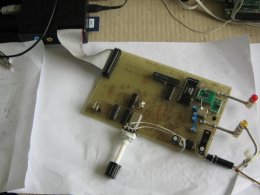Jan Panteltje
2013-07-02 16:41:23 UTC
I settled on a final design for a very simple digital TV
transmitter for the Raspberry Pi
The block diagram:
Loading Image...
The circuit diagram:
Loading Image...
The test board:
Loading Image...
Not all chips are used for this, the AD9761 and AD8346 just forget about them, it is an other project.
Loading Image...
On the Raspberry runs the latest ts2iq_pi software I wrote, source code here:
http://panteltje.com/pub/ts2iq_pi.c
Also I wrote Linux some code that supports the STV0299 chip to provide some of the same functions the MS windows Tutioune
program has,
here it shows the Hauppauge wintv Nova locked to a Raspberry Pi transmission.
http://panteltje.com/pub/xdipo_locked_to_raspberry_pi_datv_transmitter_IMG_3938.JPG
I will make this source available later, make a package for Linux, but it will only be of use if you have a budget PCI card
with a STV0299 chip...
About the block diagram,
I use 2 small FIFOs (4kx9 each) feeding into a 2x4 to 1 demultiplexer to get IQ from IQIQIQIQ.
The symbol rate generator is a transistor 6 MHz crystal oscillator followed by a 4040 counter
to make 1500k symbols per second.
A 100 MHz crystal oscillator module drives 2 74F74 flips flops to make 2 90 degrees shifted carriers at 25 MHz.
This is filtered by a simple LC circuit, and then fed to a small ring diode transmitter,
so this makes a 25 MHz exciter.
The 180 degree flipping of the I and Q by the modulation is done with 74HC86 XOR gates.
In this setup I used a GPS VCO, 15754200, mixer adds 25 MHz, this gives 1600420000 Hz, sat receiver adds 9750000000,
so I tuned to 11,350,42,000 for reception.
Of course for the amateur band you need a VCO that is 25 MHz offset of that frequency, and maybe some extra filtering.
Anyways the reason for the setup with the XOR gates and 25 MHz is that it is much less problematic to make a good 90 degrees
phase shit than when doing it at a GHz or so.
Important is now the filtering of the VCO supply can control voltage, add a PLL (prescaler with UBP1505 is already on this board).
I found my earlier problems with reception came from high phase noise caused by me forgetting to decouple the VCO tuning
voltage and supply, not by the low symbol rate, the xdipos software I wrote helped me find that in a way.
I have send some short movie over the wired link (coax directly into the DVB-S card) with this, and it came out perfectly.
I hope this simple design and software will help somebody get started on the Raspberry,
cost should be really low this way.
transmitter for the Raspberry Pi
The block diagram:
Loading Image...
The circuit diagram:
Loading Image...
The test board:
Loading Image...
Not all chips are used for this, the AD9761 and AD8346 just forget about them, it is an other project.
Loading Image...
On the Raspberry runs the latest ts2iq_pi software I wrote, source code here:
http://panteltje.com/pub/ts2iq_pi.c
Also I wrote Linux some code that supports the STV0299 chip to provide some of the same functions the MS windows Tutioune
program has,
here it shows the Hauppauge wintv Nova locked to a Raspberry Pi transmission.
http://panteltje.com/pub/xdipo_locked_to_raspberry_pi_datv_transmitter_IMG_3938.JPG
I will make this source available later, make a package for Linux, but it will only be of use if you have a budget PCI card
with a STV0299 chip...
About the block diagram,
I use 2 small FIFOs (4kx9 each) feeding into a 2x4 to 1 demultiplexer to get IQ from IQIQIQIQ.
The symbol rate generator is a transistor 6 MHz crystal oscillator followed by a 4040 counter
to make 1500k symbols per second.
A 100 MHz crystal oscillator module drives 2 74F74 flips flops to make 2 90 degrees shifted carriers at 25 MHz.
This is filtered by a simple LC circuit, and then fed to a small ring diode transmitter,
so this makes a 25 MHz exciter.
The 180 degree flipping of the I and Q by the modulation is done with 74HC86 XOR gates.
In this setup I used a GPS VCO, 15754200, mixer adds 25 MHz, this gives 1600420000 Hz, sat receiver adds 9750000000,
so I tuned to 11,350,42,000 for reception.
Of course for the amateur band you need a VCO that is 25 MHz offset of that frequency, and maybe some extra filtering.
Anyways the reason for the setup with the XOR gates and 25 MHz is that it is much less problematic to make a good 90 degrees
phase shit than when doing it at a GHz or so.
Important is now the filtering of the VCO supply can control voltage, add a PLL (prescaler with UBP1505 is already on this board).
I found my earlier problems with reception came from high phase noise caused by me forgetting to decouple the VCO tuning
voltage and supply, not by the low symbol rate, the xdipos software I wrote helped me find that in a way.
I have send some short movie over the wired link (coax directly into the DVB-S card) with this, and it came out perfectly.
I hope this simple design and software will help somebody get started on the Raspberry,
cost should be really low this way.